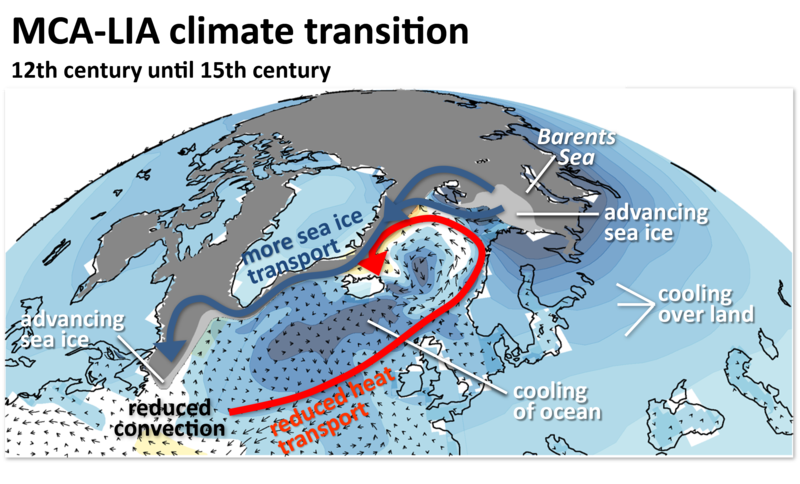Simulated on CSCS Monte Rosa supercomputer: Sea-ice formation sustained the Little Ice Age
Volcanic eruptions and reduced solar radiation caused global cooling between the thirteenth and the fifteenth centuries. The resulting accelerated formation of sea ice in the Northern Seas triggered a positive feedback process that shaped the Little Ice Age, as a new study by climate scientists from the University of Bern and the Oeschger Centre for Climate Change Research reveals.
by Simone Ulmer
The winter weather in Europe is largely governed by the so-called North Atlantic Oscillation (NAO). This air pressure seesaw between the Azores High and the Icelandic Low produces mild winters in Central and Northern Europe if the two air pressure centres are particularly pronounced and cold winters if they are weak. Until now, the NAO was believed to be jointly responsible for the cooling in the early fifteenth century along with volcanic eruptions and weakened solar radiation. The subsequent Little Ice Age continued into the nineteenth century. Now, however, Bernese climate researchers Flavio Lehner, Andreas Born, Christoph Raible and Thomas Stocker reveal that the Little Ice Age was also able to take its course without the influence of the NAO, driven purely by the consequences of strong and frequent volcanic eruptions at the time, a reduced solar radiation, or both together.
Simulating feedback mechanism
Using simulations on the CSCS supercomputer “Monte Rosa”, the climate researchers searched for a feedback process that was capable of triggering the Little Ice Age1. As the driving forces of the climate, they applied volcanic eruptions and a weakening of solar radiation in their models. Although six slightly different starting conditions were selected for the simulations, every simulation initiated the same process: in the Barents Sea, the sea-ice masses grew and spread to the warmer sub-arctic area of the North Atlantic, where they melted. The freshwater inflow resulting from the meltwater altered the water stratification and thus the differences in density. As a result, the ocean convection, driven by the density differences, was weakened and less warm water was transported into the Nordic Seas, which in turn boosted the growth of sea ice. This so-called positive feedback process intensified the Little Ice Age especially in northern latitudes.

For the first time, the scientists verified their results with a synthetic ice formation simulation, in which they allowed sea ice to grow artificially in the Barents Sea without factoring in the consequences of volcanic activity or less solar radiation. “Starting with the Barents Sea, which is still one of the ‘ice machines’ of the Arctic today, we were able to trigger the same feedback process that we had previously observed in the simulations driven solely by volcanoes and solar radiation,” says Lehner. According to the scientists, the feedback process in the models continued for up to seventy years even after the artificial ice growth had been “switched off”.
For the scientists, the fact that all the slightly altered, realistic simulations and the synthetic ice simulation yielded consistent results is solid proof that the Little Ice Age was primarily governed by external triggers. Volcanic activity and less solar radiation initially caused an increase in sea-ice formation independently of atmospheric circulation. Due to the cooling, the mean sea level pressure gradually increased over the Barents Sea, which enabled the cold air to reach Europe. “However, this pressure response is clearly a delayed reaction of the atmosphere to the preceding processes in the ocean,” says Raible.
New questions
For the Bernese climate researchers, the motivation behind this study was a previous project2 conducted in 2012, in which they used simulations to verify the hypothesis as to whether the North Atlantic Oscillation dominated the so-called Medieval Climate Anomaly (from around 800 to 1,100 years ago). The unusually warm period of the Medieval Climate Anomaly preceded the Little Ice Age. In 2009 another research team had postulated a persistent and very pronounced positive NAO during this warm period based on reconstructed precipitation data. Moreover, the researchers identified a clear transition to an oscillating, more negative NAO3 at the beginning of the Little Ice Age. Based on their results, they concluded that the NAO had a major influence on the Medieval Climate Anomaly and its transition to the Little Ice Age.
When the Bernese researchers failed to confirm these conclusions in their climate model simulations, they began to search for the plausible mechanism, now published in the Journal of Climate of the American Meteorological Society, which triggered the Little Ice Age irrespective of the NAO. The researchers are convinced that “by improving our understanding of past climate fluctuations and thus of the complex climate, we are able to gain valuable insights for possible future scenarios.” The simulations the scientists used to identify the feedback mechanism cover a time period up to the year 1500, by which time the transition to the Little Ice Age was complete. Currently, simulations are running on Monte Rosa spanning from the Medieval Climate Anomaly, which started around the year 850, to 2100. The researchers expect the first results this winter.
| References: |
| 1. Lehner F, Born A, Raible C C & Stocker T F: Amplified inception of European little ice age by sea ice-ocean-atmosphere feedbacks, Journal of Climate, 2013, doi: 10.1175/JCLI-D-12-00690.1, in press. |
| 2. Lehner F, Raible C C & Stocker T F: Testing the robustness of a precipitation proxy-based North Atlantic Oscillation reconstruction, Quaternary Science Reviews, 2012, 45, 85-94, doi: 10.1016/j.quascirev.2012.04.025 |
| 3. Trouet V et al.: Persistent Positive North Atlantic Oscillation mode dominated the medieval climate anomaly, Science, 2009, 324, 78-80, doi: 10.1126/science.1166349. |

